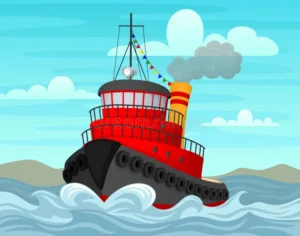A man told me this story last week:
As a teenager in the 1980s, he played basketball for his high school team. He lived on Cape Cod, and on a Friday afternoon in January, his team was scheduled to play a game against a rival team on Martha’s Vineyard. They took the ferry across Nantucket Sound, entered the opponent’s gym, and commenced battle.
As they played, a snowstorm rolled in, producing blizzard-like conditions. Meteorology wasn’t nearly as accurate back then as it is today, so although they knew snow was possible, no storm of this magnitude had been predicted.
When the game ended and the teams exited the gym, they discovered a foot of snow on the ground and more still coming.
All ferries to the mainland had been canceled.
As assistant coaches began dropping quarters into payphones to call parents to alert them to the situation and looking for hotels for the night, the head coach walked down to the pier, where a tug boat was being readied to launch. The coach asked the tugboat captain if he was headed to the mainland. When the tugboat captain said yes, the coach asked if he wouldn’t mind giving his team a ride.
The tugboat captain agreed, but the boat’s cabin was too small to fit the team, so they would need to make the journey on the deck, exposed to the snowstorm for the 45-minute journey across the sound.
The coach agreed.
So, in blizzard conditions, the basketball team boarded a small tug and made the harrowing journey across Nantucket Sound back to Cape Cod.
The man who told me the story arrived home just after 3:00 in the morning. He rang the doorbell and was greeted by a bleary-eyed father.
“I thought you were coming back tomorrow,” his dad said.
“Coach found us a ride on a tug boat.”
His father nodded and went back to bed.
I love this story.
Today, none of this would have happened. Weather forecasts would’ve canceled the game, of course, but taking a dozen teenagers across a body of water in a blizzard on a tug boat would have gotten any coach fired today.
An unscheduled trip on an uninspected, unapproved seagoing vessel.
Not a single signed permission slip.
No medical forms.
No communication with anyone on the mainland about the change in plan.
The best part:
No one cared. In the early morning hours, kids arrived home with stories of a tugboat and a blizzard, and parents nodded and went back to bed.
What a lovely time to be alive.
When I started teaching 25 years ago, the world was not very different from those tugboat days.
If a student missed the bus, I drove them home.
If a student didn’t have lunch, I would share some of mine.
One evening, a student failed to show up for one of my Shakespearean productions, so I told the audience of parents and relatives to sit tight while I raced to the child’s home, dragged him from the house, and brought him to school to perform.
After failing to inspire a student to complete homework assignments, I went to a student’s home alongside our social worker with a desk, chair, and school supplies. While the social worker talked to the boy’s grandmother about the importance of getting homework done, I went into the boy’s bedroom, placed the desk and chair in a corner, organized a workspace, and then pulled out the power cords to his two video game systems, rendering them useless.
I took those cords back to school, using them as bait to get the boy to work.
Another boy came to school late every day because his single mother could not get him out of the house on time, making her late for work. So, one morning, I arrived at the boy’s home while he was still in his pajamas. I dragged him to my car and drove him to school, still in his pajamas. The boy was angry and outraged that his classmates would see him in pajamas, but I told him he should’ve considered this before failing to get himself ready.
Five minutes before the bell rang to start the school day, I pulled out a paper bag from my desk containing a set of clothes packed by his mother. “If I give you these clothes, will you ever be late again?”
He never was.
Another boy was failing to work hard and reach his potential, so I asked my first-grade colleague if I could borrow her star student for a couple of hours. The next day, that first-grade girl sat beside my third-grade boy, ready to do third-grade work. I hoped that sitting beside a focused, hard-working first grader who was nearly capable of doing third-grade math would light a fire under the boy, who didn’t want to be matched or beaten by a student two years his junior.
It worked. The boy worked hard and learned more that day than ever before. I’m not sure if he continued to work hard because he had learned the value of hard work or was afraid to face off with the first grader again, but his improvement from that moment on was astronomical.
None of this would work today.
Administrators and some parents would reject everything I described and likely terminate my employment.
I understand why. School districts and administrators are fearful of this litigious world. Some of the things mentioned might put students at risk.
But when we fail to be creative, ridiculous, outrageous, or inventive in our efforts to inspire students to learn, we also put them at risk. School districts don’t bear the weight of that risk, because it will be realized years later, but the student— and ultimately society—will suffer.
But it’s also a relentless homogenization of education, where school districts and administrators seek to create a uniform, lock-step approach to teaching, failing to exploit teachers’ specific talents and interests. Rather than encouraging teachers to bring their gifts to the classroom, school districts often attempt to neuter those gifts, seeking a workforce that does the same thing every day, sometimes at the very same time.
It’s a disaster.
Want to know what’s wrong with education?
I have many things to say, but I’d start with that:
The attempted homogenization of the education system. The systemic elimination of joy, spontaneity, ingenuity, and creativity from the classroom.
The end of the days when you could catch a tugboat ride back to the mainland in a blizzard.








